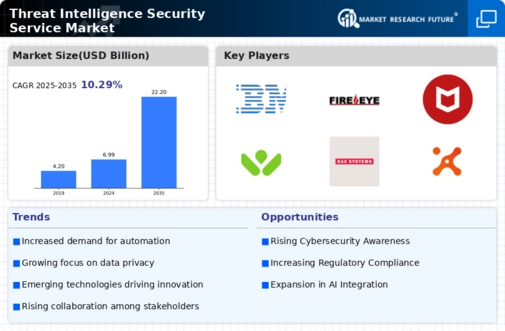Rising Cybersecurity Threats
The increasing frequency and sophistication of cyber threats is a primary driver for the Threat Intelligence Security Service Market. Organizations are facing a myriad of attacks, including ransomware, phishing, and advanced persistent threats. According to recent data, the number of reported cyber incidents has surged, prompting businesses to invest heavily in threat intelligence services. This trend indicates a growing recognition of the need for proactive measures to mitigate risks. As cybercriminals evolve their tactics, the demand for real-time threat intelligence becomes paramount. Companies are seeking solutions that not only detect threats but also provide actionable insights to prevent potential breaches. This heightened awareness and urgency among organizations to safeguard their digital assets is likely to propel the growth of the Threat Intelligence Security Service Market.
Adoption of Cloud-Based Solutions
The shift towards cloud computing is reshaping the Threat Intelligence Security Service Market. As organizations migrate their operations to the cloud, they face unique security challenges that necessitate advanced threat intelligence solutions. Cloud environments are often more vulnerable to attacks, making it essential for businesses to implement comprehensive security measures. The demand for cloud-based threat intelligence services is on the rise, as they offer scalability, flexibility, and real-time monitoring capabilities. Market data indicates that the adoption of cloud services is expected to grow, further driving the need for integrated threat intelligence solutions. This trend highlights the importance of adapting security strategies to align with cloud technologies, thereby propelling the growth of the Threat Intelligence Security Service Market.
Emergence of Advanced Technologies
The emergence of advanced technologies, such as artificial intelligence and machine learning, is significantly impacting the Threat Intelligence Security Service Market. These technologies enable organizations to analyze vast amounts of data and identify potential threats with greater accuracy and speed. The integration of AI-driven solutions into threat intelligence services is becoming increasingly prevalent, as businesses seek to enhance their threat detection and response capabilities. Market analysis suggests that the adoption of these technologies will continue to grow, driving innovation within the industry. As organizations recognize the value of leveraging advanced analytics for threat intelligence, the demand for such services is likely to increase. This trend indicates a transformative shift in how organizations approach cybersecurity, further propelling the growth of the Threat Intelligence Security Service Market.
Regulatory Compliance Requirements
The evolving landscape of regulatory compliance is significantly influencing the Threat Intelligence Security Service Market. Organizations are increasingly required to adhere to stringent regulations regarding data protection and cybersecurity. Compliance frameworks such as GDPR, HIPAA, and PCI DSS necessitate robust security measures, including threat intelligence capabilities. As businesses strive to meet these regulatory demands, they are turning to specialized services that can provide the necessary intelligence to ensure compliance. The market for threat intelligence services is expected to expand as organizations recognize the importance of integrating these solutions into their compliance strategies. This trend suggests that the intersection of regulatory requirements and cybersecurity will continue to drive investments in the Threat Intelligence Security Service Market.
Increased Investment in Cybersecurity
The surge in investment in cybersecurity initiatives is a crucial driver for the Threat Intelligence Security Service Market. Organizations are allocating substantial budgets to enhance their security postures in response to the escalating threat landscape. Recent statistics reveal that global spending on cybersecurity is projected to reach unprecedented levels, reflecting a heightened commitment to safeguarding digital assets. This influx of capital is likely to result in increased demand for threat intelligence services, as businesses seek to leverage advanced technologies and expertise to combat cyber threats. The emphasis on cybersecurity as a strategic priority underscores the critical role that threat intelligence plays in organizational resilience. Consequently, the growth of the Threat Intelligence Security Service Market appears to be closely linked to these investment trends.


















Leave a Comment